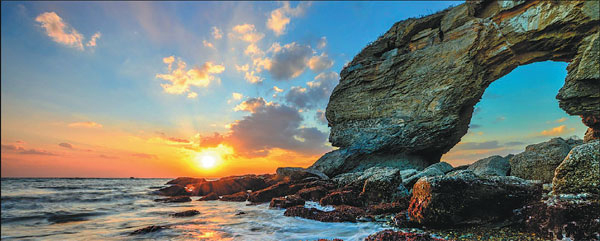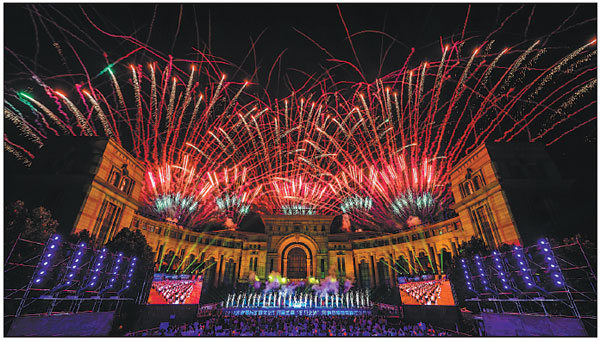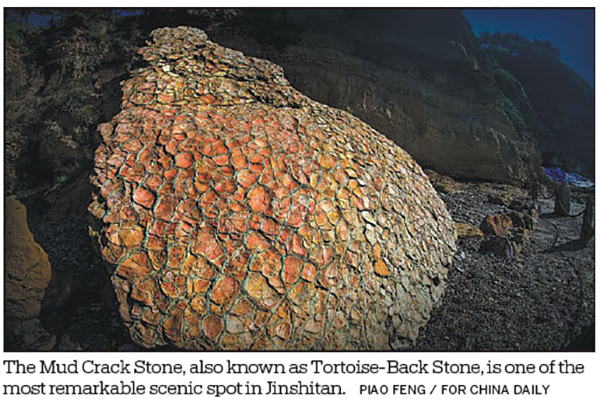Beaches, mountains and parks among offerings at national tourism destination.
Jinshitan National Tourism Resort in Dalian, a coastal city in Northeast China's Liaoning province, is wowing visitors with its crystal-clear seawater, 600-million-year-old rocks, blue sky and white-sand beaches, in its quest to become a world-class tourism destination.
"Jinshitan is one of the most beautiful places in China. We have easy access to natural resources such as beaches, sea, mountains and parks," said Nik Edwards, academic director of Great Man Dalian International Kindergarten, who has been working in Dalian for two years. "There are a lot of attractions around Jinshitan such as the geological park and the dinosaur park. For me, I like to play golf, go to the Discoveryland and the museums."

From left: Chefs display seafood at a waterfront street food stall in Jinshitan tourism resort. View of a parade at the Discoveryland Park in Jinshitan tourism resort. Jinshitan tourism resort boasts 35 kilometers of coastline. Photos Provided to China Daily

Jinshitan National Tourism Resort is wowing visitors with amazing natural landscapes. Shao Yuzheng / For China Daily

Jinshitan tourism resort is an ideal venue for conferences, sporting and cultural activities. Piao Feng / For China Daily
The tourism resort, surrounded by the Yellow Sea on three sides and boasting 35 kilometers of coastline, became a tourist destination in the 1980s. It was recognized as a national 5A scenic spot - China's highest ranking for tourism areas - by the central authority in 2000.
Liu Jinhong, director of Jinshitan National Tourism Resort, said the area received 6 million visits, with tourism income reaching 2.5 billion yuan ($351.18 million) in 2018.
Spectacular landscapes
Jinshitan's landscapes feature rocks in different shapes, believed to belong to the Sinian period and Cambrian period, and steep cliffs.
Many of the highlights of Jinshitan lie in the strange rocks that resemble shapes of animals and even human beings, like monkeys, dinosaurs, huge birds, crabs and even the head of famous composer Beethoven. Some people say this region is a natural geological museum, while others say it is a sculpture park created by nature.
According to Shan Xuedong, vice-director of the Liaoning Provincial Institute of Geological Exploration, the area's landscape was formed by long-term erosion by seawater.
Shan also noted the area has various layers formed at the junction of the Sinian and Cambrian periods, due to the deposit of silts.
"Such a landform is rarely seen in the rest of the country and it offers valuable evidence for the study of ancient geology and environment," Shan said.
"A casual snapshot here can make for a great photograph," said Bi Yunfeng, general manager of Jinshitan Tourism Group, adding the clear seawater and white-sand beaches in Jinshitan ensure a wonderful experience for both geological professionals and leisure-seeking travelers.
One of the most remarkable feature in Jinshitan is the Mud Crack Stone, which is also known as Tortoise-Back Stone.
The huge stone is a rare sedimentary rock displaying a wonderful mud-crack structure.
There are two views about the origin of this site among scientists.
Some believe the mud crack occurred when calcic silts were deposited and then exposed aerially in the dry and hot weather about 540 million years ago. Another opinion is that the site was formed when an earthquake caused cracks perpendicular to the rock bedding.
Venue for big events
Premium natural resources and well-equipped infrastructure have made the national tourism resort an ideal venue for conferences, sporting activities and cultural events.
In recent years, events have included the Dalian International Beach Culture Festival, the Winter Swimming Festival, the International Beach Volleyball Competition and the International Wedding Tour Festival, as well as events for sailing, marathon and dancing.
One of the highlighted events held this year in Jinshitan is the Dalian International Beach Culture Festival, with this year's session held from July to September. The 2019 China Underwater Robot Professional Contest was held in August as part of the celebration. A total of 35 teams from around China gathered at the resort to demonstrate their underwater technologies.
In addition, the 2019 Luhua Cup Chinese Cuisine World Championship, participated in by 200 chefs from around the world, was also held in August. The event helped promote traditional Chinese food culture and industry exchanges, according to event organizers.
A professional sand painting competition targeting teenagers, while a volleyball competition and an international art festival were also organized in August to entertain attendees.
Liu said the beach culture festival, which integrates many technologies into its creation, attracts great attention from local residents and plays an important role in driving the economy in Jinpu New Area, where the resort is located. The festival is helping boost Dalian's global presence.
Quality development
The administration in Jinshitan has long been working to better connect with premium tourism operators and learn from their experiences.
A seminar, attended by government officials and tourism experts was held in Jinpu at the end of June to discuss Jinshitan's future development plan.
Zhan Dongmei, a researcher from the China Tourism Academy, said the resort has to differentiate its tourism offerings from those of its peers. The resort can also explore opportunities from the nighttime economy which is gaining momentum in China.
According to market consultancy iMedia Research, 60 percent of consumption in China occurs at night. In the past three years, the country's nighttime consumption has grown by 17 percent annually on average.
Liu said more preferential policies will be unveiled to enhance education and healthcare services in the resort to retain young people.
"This might be a dream job, working at an international hotel in a national 5A-rated resort," said Li Ruixue, commercial director of Hilton Dalian Golden Pebble Beach Resort. "Most of the guests come to embrace the sea, the beach, the sunshine and the fresh air. They are happy every day and we are happy to serve them."
Li said that when the hotel started operations last June, the occupancy rate was higher than 90 percent.
Jinshitan, a land of plenty, is showing its unique charm to global investors.
A groundbreaking ceremony for Jinshitan Kyoto-style Street was held at the end of August. In the project, a small town combining key architectural elements of the Tang Dynasty (618-907) and Japan's traditional buildings will be erected in the tourism resort. A total of 6 billion yuan will be invested to build hotels, restaurants, shopping malls, cultural centers, leisure facilities and residential properties in upcoming years.
Ken Ishihara, a board member of the Japan Hotel Association, said he is very optimistic about the project and his association will help introduce Japanese businesses to the street.
Ishihara said the association has been in touch with more than 50 member enterprises in Japan and shared the project plan with them.
According to Liu, 12 large projects, involving a total investment of 15.56 billion yuan, are under construction in the resort.
Twenty large projects with a combined investment of nearly 50 billion yuan are also under negotiation.
Looking ahead, the national tourism resort will promote the idea of all-for-one tourism and implement quality development concepts to maintain long-term development. It will embrace technologies such as the internet, the internet of things and big data to better serve consumers' varying appetites, Liu said.
Administrators of the resort will strive to build a world-class tourism destination which integrates industries such as culture, healthcare, leisure, ecology, sports and education under one roof.
